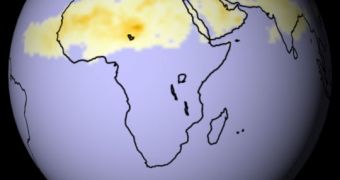Pollution on Earth is a very real threat to all lifeforms and its negative effects on organisms are well known, so countermeasures will have to be taken, if we all want to survive on the Blue Planet as we did before. But how do you find a source of pollution located far from where the effects are noticed?
A group of scientists at Colorado State University are trying to do just that. They want to learn how the various sources of pollution, like auto exhaust gases, oil refining residues, biomass burning, affect the air in a city like Mexico City.
They are tracking this by studying the reduction of solar ultraviolet radiation by atmospheric particles. This way, they hope to learn the location of where the air people breathe originally came from by studying the optical properties of aerosols and by combining them with computer forecast models.
Aerosols are a suspension of matter particles "floating" in the air, a mixture in which solid or liquid or combined solid-liquid particles are suspended in a fluid. It's like a spray containing acids, water, black carbon or dust.
They can alter the amount of solar radiation that reaches the surface of the Earth and can also change the heating and circulation in the atmosphere. Natural aerosols also exist, like the ones produced by volcanoes, dust storms, sea salt spray and forest fires, but the most dangerous are artificial ones, produced by human activity such as burning fossil fuels.
"Aerosols contribute to human health problems such as emphysema and respiratory problems," said Jim Slusser, Colorado State senior scientist and director of the UVB Monitoring and Research Program. "It is only when strict mitigation, regulatory standards and stiff fines for non-compliance were pushed through Congress that U.S. cities began to reduce harmful sulfur and black carbon aerosols. The data from our research will help decision makers in Mexico choose between various mitigation and adaptation strategies in regards to the dense pollution."
Every three minutes, solar measurements from the UV to the near infrared are made at 36 climate stations established by Colorado State, considered to be critical information in monitoring the atmospheric pollution, unavailable from any other applications. "Aerosols can either cool or warm the planet depending largely on the amount and proportion of radiation that they scatter rather than absorb. With sufficient sites, we can use our instrumentation, combined with satellite retrievals, to make measurements to validate global models on mitigation strategies for reducing the greenhouse warming aerosols around the world. As in the case of ozone depletion, this effort will require participation with scientists, government and industry. "
"Less absorbing aerosols will result in more damaging UV and greater production of tropospheric ozone. The Mexicans are in a dilemma in that even if they cleaned up the soot and black carbon from the diesel exhaust, the now scattering aerosol will result in more potential damaging UVB and ozone," Slusser said.

 14 DAY TRIAL //
14 DAY TRIAL //